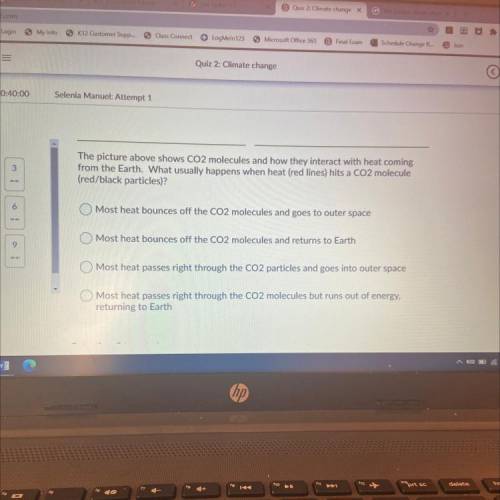
Biology, 10.02.2021 01:00 rodriguezzamyy
The picture above shows CO2 molecules and how they interact with heat coming
from the Earth. What usually happens when heat (red lines) hits a CO2 molecule
(red/black particles)?
Most heat bounces off the CO2 molecules and goes to outer space
Most heat bounces off the CO2 molecules and returns to Earth
Most heat passes right through the CO2 particles and goes into outer space
Most heat passes right through the CO2 molecules but runs out of energy,
returning to Earth
A KI2


Answers: 1


Another question on Biology

Biology, 21.06.2019 21:00
What can be found in every skeletal muscle? a. nerves, bones, cartilage, and connective tissue b. tendons, cartilage, nerves, and blood vessels c. muscle fibers, nerves, connective tissue, and blood vessels d. tendons, nerves, blood vessels, and bones
Answers: 3

Biology, 22.06.2019 04:00
Will mark brainliest i only need the ! 1.use ten beads and a centromere of one color to construct the long chromosome. use ten beads and a centromere of a second color to construct the second chromosome in the long pair. make a drawing of the chromosomes in the space below. 2. for the second pair of chromosomes, use only five beads. 3. now model the replication of the chromosomes. make a drawing of your model in the space below. part b: meiosis i during meiosis i, the cell divides into two diploid daughter cells. 4. pair up the chromosomes to form tetrads. use the longer tetrad to model crossing-over. make a drawing of the tetrads in the space below. 5. line up the tetrads across the center of your “cell.” then model what happens to the chromosomes during anaphase i. 6. divide the cell into two daughter cells. use the space below to make a drawing of the result. part c: meiosis ii during meiosis ii, the daughter cells divide again. 7. line up the chromosomes at the center of the first cell, one above the other. separate the chromatids in each chromosome and move them to opposite sides of the cell. 8. repeat step 7 for the second cell. 9. divide each cell into two daughter cells. use the space below to make a drawing of the four haploid cells
Answers: 1

Biology, 22.06.2019 05:10
1) what three conditions must be present for minerals to form through natural processes? 2) why are minerals considered inorganic substances? 3) how do oxides differ from other minerals that contain oxygen atoms? 4) how is a sulfide different from a sulfate? what makes native elements unique?
Answers: 2

You know the right answer?
The picture above shows CO2 molecules and how they interact with heat coming
from the Earth. What u...
Questions

History, 14.04.2020 01:06


Chemistry, 14.04.2020 01:07



History, 14.04.2020 01:08


Social Studies, 14.04.2020 01:08

English, 14.04.2020 01:21

Mathematics, 14.04.2020 01:21



Mathematics, 14.04.2020 01:22

History, 14.04.2020 01:22

Computers and Technology, 14.04.2020 01:22

English, 14.04.2020 01:22


English, 14.04.2020 01:22

English, 14.04.2020 01:22



